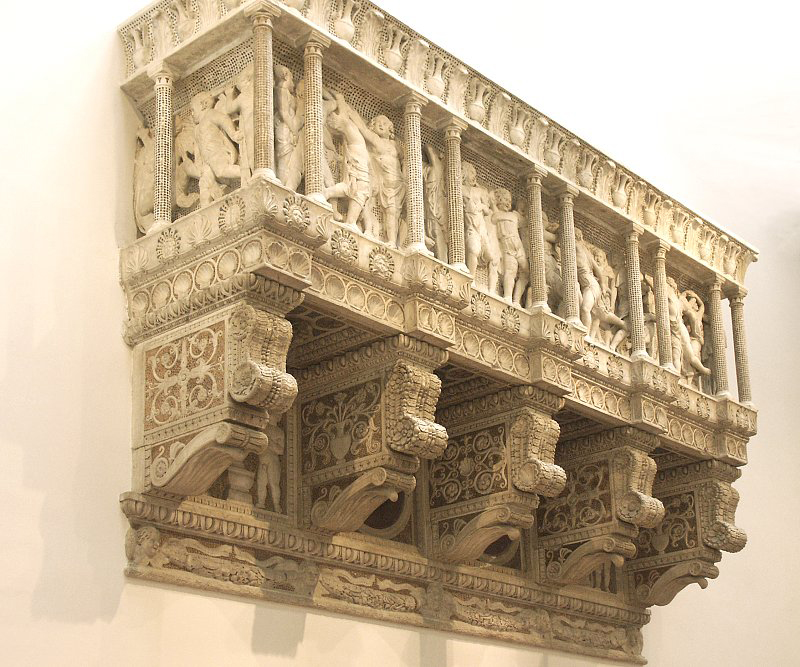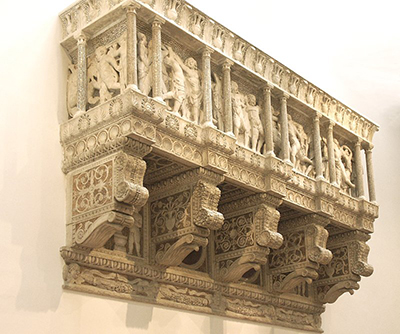Completed between 1433 and 1439 by the master sculptor Quatrocento Donatello, Cantoria is a masterwork in marble
Stunning in its detail, this work measures 3.48 x 5.70 meters. In this work one gets a clear sense of Donatello's fascination with the classical art of antiguity, albeit bestowed with the beauty and vivacity that is uniquely characteristic of Donatello.
This piece was commisioned for the Duomo or dome of the main cathedral in Florence as part of a larger program that sought to embellish the appearance of the Duomo's interior facade. Prior to beginning his work on Cantoria in 1433, the Italian sculptor Luca della Robbia had completed a piece that was thematically similar and around the same size. This sculpture was placed near the cathedral's organ.
The piece commissioned of Donatello was meant to provide a stage of sorts for members of the church choir. The very word Cantoria means chancel, which is the area in a church near the altar that provides standing room for the choir and clergy. The word could also be construed to mean choir and in fact the piece was nicknamed the singing gallery.
Donatello carried out work on the Cantoria in the area of the cathedral where the Latin cross shaped section of the cathedral in Florence intersects. The Cantoria sculpture is a rectangular structure with balconies or galleries that appear in relief making allusive representations to singers. This sculptural work would fit in Donatello's second period, otherwise referred to as the Poetic-Classical period, which spans the ten years between 1433 and 1443. During this time Donatello worked for the Medici in the city of Florence.
The Medici were a highly influential dynastic family—one of the most powerful in all of Europe. They essentially commanded Florence for over three centuries thanks to having founded the Medici bank. Their contribution to art was profound during the renaissance. The patriarch of the Medici was Giovanni di Bicci otherwise known as Juan de Medici (1360-1429) a man born of very humble beginnings in the rural area outside of Florence who would go onto amass great wealth. In addition to being the founder of the Medici bank he was also extremely close with Pope John XXIII, and the Medici bank was given the responsibility for handling the sizable pontifical coffers.
Donatello had spent significant time in Rome studying the great artists of ancient times and carefully assimilating many of their stylistic and formal elements. For instance, in Cantoria we can see the use of putti or winged children who appear to be singing and dancing through a narrow space. This return to classical form characterized many renaissance artists.
Lucca della Robbia also carved his own cantoria or chancel, but in his the influence of classicism is understood in a completely different light. In contrast, with Donatello's work we see a much more balanced composition that is marked by bold and vertical columns that contrast with the tension and movement of the human figures and their curvilinear forms.
When viewed as a whole, there is an ornamental richness to the piece with its many motifs representing children, flowers, and other plants. The many columns that come together with the cantilevers and the inlays of gold, green and red tile that speak not only to Donatello's amazing technical ability but also the way he makes use of saturated and full colors. The way the shafts of the columns accompany the figures in mid movement is also particularly impressive.
All of these different composition elements come together to give the entire work a magnificent sense of dynamism when taken in by the eye from a distance and in its entirety. At the same time, when each individual figure is viewed up close in order to observe its individual gesture, this too has its own particular and tangible charm.
In the bottom center of the piece we can see busts in black bronze arranged in a circular pattern which are flanked on the inside by sculpted renderings of children. This second period of Donatello's work is characterized by lots of adolescent and child figures, given that his artistic vision was still less dramatic. This is affirmed by the pleasant sun faces we see in the work's cornice.
Nonetheless, the Cantoria was received somewhat critically when it was first completed. Much of the imagery that Donatello infused into the piece was viewed as being coarse and plump and were seen as being improper, perverse, and not in tune with the idealized aesthetic and concepts of decency of the time. At any rate, today the Cantoria is considered to be an absolute masterwork and is on display at the Museo dell Opera del Duomo de Florencia.

from Amazon




